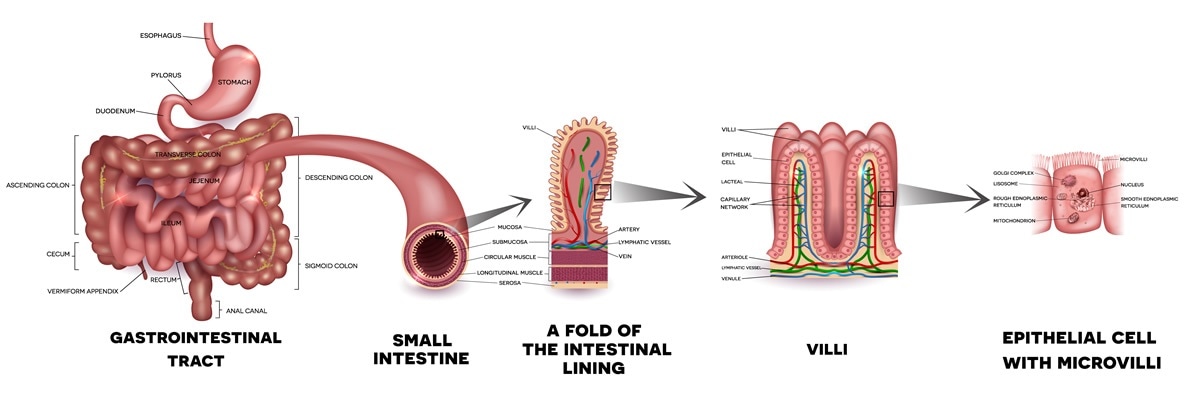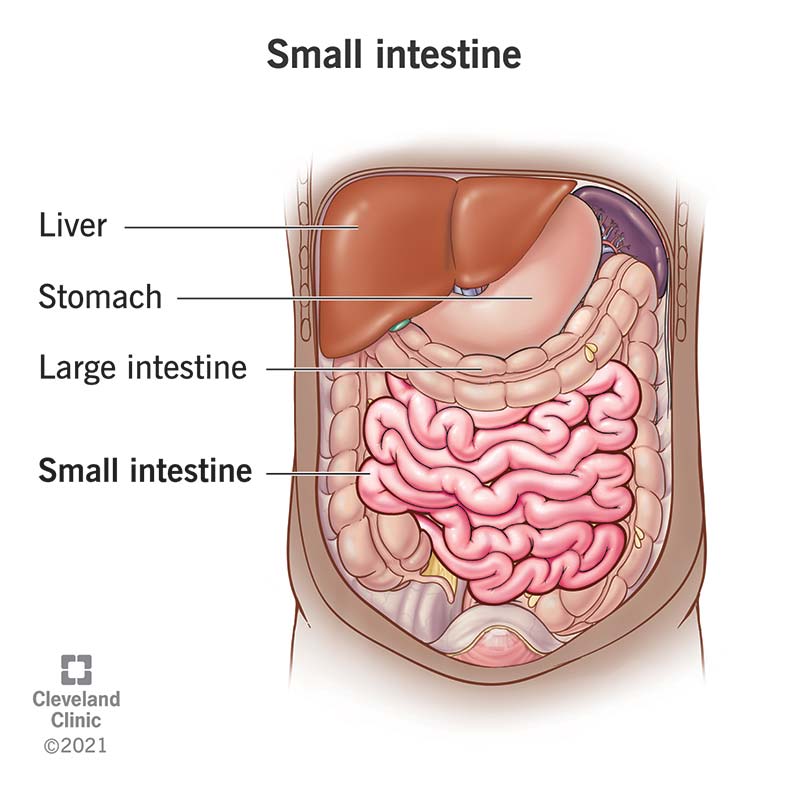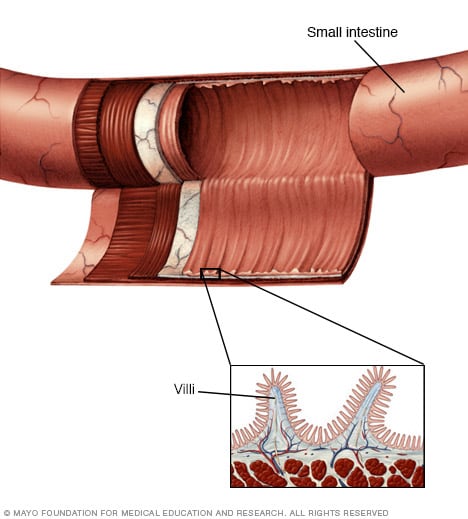Describe the Lining of the Small Intestine
These sugars are known as glucose. Recent work has shown that the cells of the lining are covered by a membrane that actively digests foods and speeds nutrients into the blood Nutrients appear to enter the body through the mouth but in a more profound sense nothing becomes part of the body until it has.

Solved The Lining Of The Small Intestine Is Build Unique For Chegg Com
It is shorter than the small.

. All these simple broken down forms are called the digested food. The small intestine has a ridged lining covered with tiny fingerlike projections called villi. To help break food down the small intestine receives digestive juices from other organs in your digestive.
It lies between the stomach and large intestine and receives bile and pancreatic juice through the pancreatic duct to aid in digestion. The majority of the small intestine adventitia is covered by mesothelium and is commonly called the serosa. Exterior of the stomach removed from the fetal pig body.
Experts are tested by Chegg as specialists in their subject area. In order to achieve this the cells of the small intestine have adaptations to increase their ability to absorb. The small intestine is part of the digestive system and is mainly responsible for the absorption of nutrients.
The lining is highly folded to form microscopic finger-like projections called villi which increase the surface area to help with absorption. It also converts the proteins into amino acids. Epithelial cells on the villi are responsible for absorption of nutrients.
It has a lining which is designed to absorb carbohydrates and proteins. A process called _____ helps to propel first the bolus and then chyme forward through the esophagus stomach and small intestine. Many little folds that look like little hills line the inside of the stomach.
Who are the experts. However underneath the microscope it is a lighter pink with a yellowish tinge. Check-in - look at the structure of the lining of the small intestine.
The Small Intestinal Lining is one cell layer thick. The inner lining of the small intestine has numerous fingers like projections for villi which increase the surface area and helps in absorption of nutrients. The purpose of the small intestine is to absorb nutrients from the food we eat.
The cells that make up the lining of the small intestine have villi on their surface. Describe how this structure specifically the villi microvilli allow the small intestine to efficiently perform its function. You can see that this type of epithelium which is lining the lumen of the jejunum of the small intestine is a simple epithelium.
After chemical digestion in the duodenum food moves into the jejunum where the muscle work of digestion picks. Its this delicate lining that protects you from billions of microbes circulating in your intestines. We review their content and use your feedback to keep the quality high.
Wall of the small intestine contains numerous gland that secretes intestinal juices containing amylolytic proteolytic lipolytic enzymes for the complete edition of Carbohydrate protein and fat. The small intestine or small bowel is an organ in the gastrointestinal tract where most of the end absorption of nutrients and minerals from food takes place. Lumen Microvill Hepatic portal vein To Liver Muscle layers Epithelium Lumen Capillary bed Vill Lacteal intestine Vill.
The lining is covered in villi and microvilli. How do the different parts of the small intestine work. But mucosa of small intestine possess villi which are finger like projections which increase surface are for absorption Villi are absent in.
Imagine cutting a strand of your hair lengthwise. The small intestines are the location where 90 of the digestion and absorption actions occur whereas the other 10 occur in the stomach and large intestines. The jejunum is the middle section of the small intestine.
These look a bit like fingers on our hands and basically increase. The Lining of the Small Intestine It was long assumed to be a passive tissue. It is only one cell layer thick and columnar as the cells are rather tall.
The intestinal juice secreted by the walls of the small intestine breaks down starch and carbohydrates into simple sugars. Because of the dependence of the host on adequate nutrient absorption the small intestine must be able to protect against pathogenic infection but not interfere with this important process. This lining starts from your sinus all way down to rectum.
Most of these cells also have short apical microvilli. The small intestine is most commonly affected by diseases such as Crohns disease or chronic infection as a result of defects in the innate immune response. This is how THIN your lining is.
These structures in the small intestine absorb nutrients and consist of a brush border which increases the small intestines absorptive capacity. The lining of the small intestinal mucosa is very highly specialized for maximizing digestion and absorption of nutrients. The inner lining of esophagus structurally.
The inner surface of the jejunum its mucous membrane is covered in projections called villi which increase the surface area of tissue available to absorb nutrients from the gut contents. Note the basal lamina at the base of the epithelium. Describe the specific structural and functional differences in the inner lining of the esophagus stomach small intestine and large intestine.
Structure and Components The small intestine also known as the small bowel is a long continuous tube that runs from the stomach to the anus. Learn about the structure of. Peristalsis Nutrients are absorbed through the lining of the small intestine via a variety of mechanisms.
The small intestine is the major absorptive site in the gastrointestinal tract and therefore has a number of modifications to aid its function. In some places you can see the apical area where junctions are located. Up to 24 cash back The inner lining of the stomach as viewed by the eye appears to be a dull pink--almost brown.
The small intestine is longer than the large intestine.

Small Intestine Function Anatomy Definition

Comments
Post a Comment